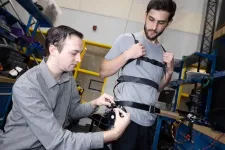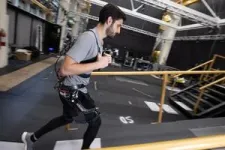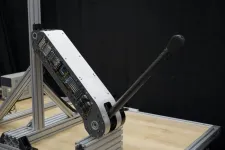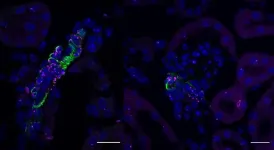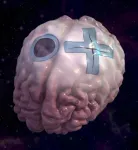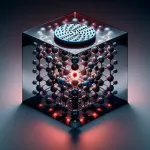(Press-News.org) Robotic exoskeletons designed to help humans with walking or physically demanding work have been the stuff of sci-fi lore for decades. Remember Ellen Ripley in that Power Loader in Alien? Or the crazy mobile platform George McFly wore in 2015 in Back to the Future, Part II because he threw his back out?
Researchers are working on real-life robotic assistance that could protect workers from painful injuries and help stroke patients regain their mobility. So far, they have required extensive calibration and context-specific tuning, which keeps them largely limited to research labs.
Mechanical engineers at Georgia Tech may be on the verge of changing that, allowing exoskeleton technology to be deployed in homes, workplaces, and more.
A team of researchers in Aaron Young’s lab have developed a universal approach to controlling robotic exoskeletons that requires no training, no calibration, and no adjustments to complicated algorithms. Instead, users can don the “exo” and go.
Their system uses a kind of artificial intelligence called deep learning to autonomously adjust how the exoskeleton provides assistance, and they’ve shown it works seamlessly to support walking, standing, and climbing stairs or ramps. They described their “unified control framework” March 20 in Science Robotics.
“The goal was not just to provide control across different activities, but to create a single unified system. You don't have to press buttons to switch between modes or have some classifier algorithm that tries to predict that you're climbing stairs or walking,” said Young, associate professor in the George W. Woodruff School of Mechanical Engineering.
Machine Learning as Translator
Most previous work in this area has focused on one activity at a time, like walking on level ground or up a set of stairs. The algorithms involved typically try to classify the environment to provide the right assistance to users.
The Georgia Tech team threw that out the window. Instead of focusing on the environment, they focused on the human — what’s happening with muscles and joints — which meant the specific activity didn’t matter.
“We stopped trying to bucket human movement into what we call discretized modes — like level ground walking or climbing stairs — because real movement is a lot messier,” said Dean Molinaro, lead author on the study and a recently graduated Ph.D. student in Young’s lab. “Instead, we based our controller on the user’s underlying physiology. What the body is doing at any point in time will tell us everything we need to know about the environment. Then we used machine learning essentially as the translator between what the sensors are measuring on the exoskeleton and what torques the muscles are generating.”
With the controller delivering assistance through a hip exoskeleton developed by the team, they found they could reduce users’ metabolic and biomechanical effort: they expended less energy, and their joints didn’t have to work as hard compared to not wearing the device at all.
In other words, wearing the exoskeleton was a benefit to users, even with the extra weight added by the device itself.
“What’s so cool about this is that it adjusts to each person's internal dynamics without any tuning or heuristic adjustments, which is a huge difference from a lot of work in the field,” Young said. “There's no subject-specific tuning or changing parameters to make it work.”
The control system in this study is designed for partial-assist devices. These exoskeletons support movement rather than completely replacing the effort.
The team, which also included Molinaro and Inseung Kang, another former Ph.D. student now at Carnegie Mellon University, used an existing algorithm and trained it on mountains of force and motion-capture data they collected in Young’s lab. Subjects of different genders and body types wore the powered hip exoskeleton and walked at varying speeds on force plates, climbed height-adjustable stairs, walked up and down ramps, and transitioned between those movements.
And like the motion-capture studios used to make movies, every movement was recorded and cataloged to understand what joints were doing for each activity.
The Science Robotics study is “application agnostic,” as Young put it. Yet their controller offers the first bridge to real-world viability for robotic exoskeleton devices.
Imagine how robotic assistance could benefit soldiers, airline baggage handlers, or any workers doing physically demanding jobs where musculoskeletal injury risk is high.
END
Universal controller could push robotic prostheses, exoskeletons into real-world use
Aaron Young’s Georgia Tech team has developed a wear-and-go approach that requires no calibration or training.
2024-03-20
ELSE PRESS RELEASES FROM THIS DATE:
Autism acceptance varies across countries – where should we target support?
2024-03-20
Societal acceptance of autism varies considerably across different countries, with lowest levels of acceptance found in Japan and Belgium, new research shows.
A survey of 306 autistic individuals from eight countries revealed that around three quarters of respondents do not feel accepted, or only sometimes feel accepted, as an autistic person. Among these countries, participants in Japan and Belgium reported the lowest levels of acceptance, while those in Canada, the UK, and South Africa reported comparatively higher levels.
The study, published in PLOS ONE, is the ...
A replacement for traditional motors could enhance next-gen robots
2024-03-20
Whether it’s a powered prosthesis to assist a person who has lost a limb or an independent robot navigating the outside world, we are asking machines to perform increasingly complex, dynamic tasks. But the standard electric motor was designed for steady, ongoing activities like running a compressor or spinning a conveyor belt – even updated designs waste a lot of energy when making more complicated movements.
Researchers at Stanford University have invented a way to augment electric motors to make them much more efficient at performing dynamic ...
Icy impacts: Planetary scientists use physics and images of impact craters to gauge the thickness of ice on Europa
2024-03-20
WEST LAFAYETTE, Ind. — Sometimes planetary physics is like being in a snowball fight. Most people, if handed an already-formed snowball, can use their experience and the feel of the ball to guess what kind of snow it is comprised of: packable and fluffy, or wet and icy.
Using nearly the same principles, planetary scientists have been able to study the structure of Europa, Jupiter’s icy moon.
Additional Information
When worlds collide: Studying impact craters to uncover the secrets of the solar system
Breaking in a new planet
Purdue scientists and engineers push the boundaries of space knowledge, studying the ...
Ancient giant dolphin discovered in the Amazon
2024-03-20
Measuring between 3 to 3.5 meters, 16 million years old: Paleontologists from the University of Zurich have announced the discovery of a new species of freshwater dolphin in the Peruvian Amazon region. Surprisingly, its closest living relatives can be found in the river dolphins of South Asia.
River dolphins are among the rarest modern cetaceans, with most extant species critically endangered. Despite their similar appearance, however, these animals are not directly related, but represent the late survivors of different cetacean groups that once inhabited our planet.
An international ...
Study suggests an ‘odor sensor’ may explain male and female differences in blood pressure
2024-03-20
Using data from both mice and humans, a Johns Hopkins Medicine research team has found that a cell surface protein that senses odors and chemicals may be responsible for — and help explain — sex differences in mammalian blood pressure. The unusual connection between such protein receptors and sex differences in blood pressure, reported in the March 20 issue of Science Advances, may lead to a better understanding of long known differences in blood pressure between females and males.
Blood ...
Repairing patients’ dura more durably
2024-03-20
Repairing patients’ dura more durably
Highly adhesive and mechanically strong Dural Tough Adhesive addresses multiple limitations in the repair of the dural membrane lining the brain and spinal cord after trauma and surgeries.
By Benjamin Boettner
(BOSTON) — The dural membrane (dura) is the outermost of three meningeal layers that line the central nervous system (CNS), which includes the brain and spinal cord. Together, the meninges function as a shock-absorber to protect the CNS against trauma, circulate nutrients throughout the CNS, as well as remove waste. The dura also is a critical biological barrier that contains cerebrospinal fluid (CSF) surrounding ...
Quantum talk with magnetic disks
2024-03-20
Quantum computers promise to tackle some of the most challenging problems facing humanity today. While much attention has been directed towards the computation of quantum information, the transduction of information within quantum networks is equally crucial in materializing the potential of this new technology. Addressing this need, a research team at the Helmholtz-Zentrum Dresden-Rossendorf (HZDR) is now introducing a new approach for transducing quantum information: the team has manipulated quantum bits, so called qubits, by harnessing the magnetic field ...
Earlier retirement for people with chronic musculoskeletal pain
2024-03-20
Frequent musculoskeletal pain is linked with an increased risk of exiting work and retiring earlier, according to a new study from the University of Portsmouth.
The paper published this week in open-access journal PLOS ONE found the association between musculoskeletal pain and retiring earlier persisted even after accounting for working conditions, job satisfaction and sex.
Dr Nils Niederstrasser and colleagues used data on 1,156 individuals aged 50+ living in England who took part in the English Longitudinal Study of Ageing. Over the course of the 14-year data collection period, 1,073 of the individuals retired.
The researchers found that people with musculoskeletal ...
Tiny magnetic implants enable wireless healthcare monitoring
2024-03-20
A millimeter-scale, chip-less and battery-less implant can wirelessly monitor a series of parameters within your body and communicate with a wearable device attached on the skin. In a recent study published in the journal Science Advances, researchers from Peking University have unveiled a miniaturized implantable sensor capable of health monitoring without the need of transcutaneous wires, integrated circuit chips, or bulky readout equipment, thereby reducing infection risks, improving biocompatibility, and enhancing portability.
Han Mengdi from Peking University, the lead researcher of ...
New study suggests that while social media changes over decades, conversation dynamics stay the same
2024-03-20
Published in Nature, a new study has identified recurring, ‘toxic’ human conversation patterns on social media, which are common to users irrespective of the platform used, the topic of discussion, and the decade in which the conversation took place.
In particular, the study suggests that prolonged conversations on social media are more prone to toxicity, and polarisation, when divergent viewpoints from debate lead to an escalation of online disagreement.
Contrary to the prevailing assumption, the study suggests that toxic interactions do not deter users from engagement, they actively participate in conversations. It also suggests that toxicity ...
LAST 30 PRESS RELEASES:
Heart-brain connection: international study reveals the role of the vagus nerve in keeping the heart young
Researchers identify Rb1 as a predictive biomarker for a new therapeutic strategy in some breast cancers
Survey reveals ethical gaps slowing AI adoption in pediatric surgery
Stimulant ADHD medications work differently than thought
AI overestimates how smart people are, according to HSE economists
HSE researchers create genome-wide map of quadruplexes
Scientists boost cell "powerhouses" to burn more calories
Automatic label checking: The missing step in making reliable medical AI
Low daily alcohol intake linked to 50% heightened mouth cancer risk in India
American Meteorological Society announces Rick Spinrad as 2026 President-Elect
Biomass-based carbon capture spotlighted in newly released global climate webinar recording
Illuminating invisible nano pollutants: advanced bioimaging tracks the full journey of emerging nanoscale contaminants in living systems
How does age affect recovery from spinal cord injury?
Novel AI tool offers prognosis for patients with head and neck cancer
Fathers’ microplastic exposure tied to their children’s metabolic problems
Research validates laboratory model for studying high-grade serous ovarian cancer
SIR 2026 delivers transformative breakthroughs in minimally invasive medicine to improve patient care
Stem Cell Reports most downloaded papers of 2025 highlight the breadth and impact of stem cell research
Oxford-led study estimates NHS spends around 3% of its primary and secondary care budget on the health impacts of heat and cold in England
A researcher’s long quest leads to a smart composite breakthrough
Urban wild bees act as “microbial sensors” of city health.
New study finds where you live affects recovery after a hip fracture
Forecasting the impact of fully automated vehicle adoption on US road traffic injuries
Alcohol-related hospitalizations from 2016 to 2022
Semaglutide and hospitalizations in patients with obesity and established cardiovascular disease
Researchers ‘listen in’ to embryo-mother interactions during implantation using a culture system replicating the womb lining
How changing your diet could help save the world
How to make AI truly scalable and reliable for real-time traffic assignment?
Beyond fragmented markets: A new framework for efficient and stable ride-pooling
Can shape priors make road perception more reliable for autonomous driving?
[Press-News.org] Universal controller could push robotic prostheses, exoskeletons into real-world useAaron Young’s Georgia Tech team has developed a wear-and-go approach that requires no calibration or training.
